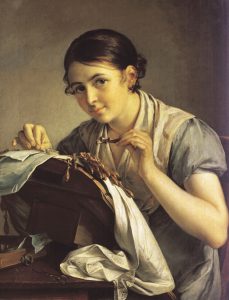Throughout history, lower classes in practically every society have been severely disadvantaged and depressed, often without hope of improving their circumstances or social mobility. Almost never has this been more true than in Tsarist Russia. Before the Serfs were liberated by Alexander II in 1861, they were bonded to the land they worked. Without being overly pessimistic, the Serfs had very little going for them during the time most of the painters we studied for today were active. Although Orest Kiprensky was technically born a serf, he was quickly sent off to boarding school at the Imperial Academy of Arts, no doubt an educational institution for the privileged. In this way, he was divorced from serfdom, and from the direct experiences of the group he was born into. He, like so many of his contemporaries, spent extensive time in Western Europe, specifically Italy. This travel, especially at the time, would have been a luxury incomprehensible to 99% of the Russian population. Briullov was educated at the Academy as well, and also traveled widely. This was also the case for Alexander Ivanov. Tropinin was born into serfdom, but lucked into an Academy education, and probably had an experience far from his family and those he grew up with. Alexei Venetsianov came from a privileged merchant background. His wealth and stature is evident considering the fact that he “bought a village” and “painted scenes of peasants and rural life”. As a member of the “higher” classes, and definitely not a serf, it is easy to see why Venetsianov painted pictures showing happy peasants. He would have wanted to believe, like we all do in some way, that he was not complicit in the suffering of classes lower than his own. This is plainly evident in this portrait of a radiant peasant girl plowing the fields in spring, exerting no energy.
Venetsianov’s reasons for painting bucolic serf and peasant scenes are closely aligned with the experiences of Briullov and Ivanov. This doesn’t explain why Kiprensky and Tropinin painted peasant scenes free of turmoil, as they were both “from” the lower classes in a way, and would have a better understanding of their struggle. It comes down to marketing: Kiprensky and Tropinin needed to sell paintings to nobles and aristocrats who had no interest in seeing pain and suffering on their walls, particularly in the context of the serfs they oppressed. This is evident in Tropinin’s portrait “The Lace Maker” which depicts a peasant girl approaching her labor with the utmost serenity and grace.

This would have been a very non-confrontational image for the aristocracy to view and purchase. It only supports their world view. Thus, Tropinin and Kiprensky compromised their knowledge of the true peasant experience to obtain the widespread dispersion and appreciation of their art.

